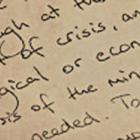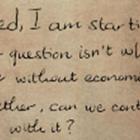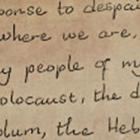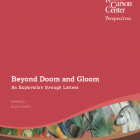Letter from Massimo Moraglio to Elin Kelsey
Massimo Moraglio is a senior researcher in urban planning history, currently at the Technische Universität Berlin, Germany.
Elin Kelsey is an educator, researcher, and author, currently teaching at the Royal Roads University in British Columbia, Canada.
Dear Elin,
Your inquiry about the “doom and gloom” mind-set that marks the environmental perspective is very sharp. On one hand, we all know that climate change is something negatively affecting our lives. So, there are plenty of reasons to be worried, and surely not so many to feel hopeful. Yet on the other hand, continuing to hopelessly list further losses of the world as we know it leaves us nailed in despair.
I do wonder if one of our duties as scholars working on environmental studies shouldn’t be to address the issue of doom and gloom in a reflexive way. Shouldn’t it be our responsibility to analyze the reasons behind the widespread impotence we feel when we discuss the state of the environment? Shouldn’t we explore the cultural background of hopelessness?
In the spirit of that investigation, I think it is important to notice how the whole discussion of environmental issues is framed by time. Experiencing climate change, witnessing the deterioration of nature, and discovering loss in the planet bio-diversity can only be done only from a historical prospective. Such issues demand that we compare the present to the past. And as we process that data, we develop trends and project these trends into the future. We make forecasts for coming generations.
I wonder if the way we frame environmental issues in terms of time and westernized conceptions of trends fuels a morbid attitude toward envisioning bad futures. Let’s have a look at some of the most famous depictions of the future in the twentieth century. We can count on Orwell, Huxley and Shiel: they all depicted dystopian futures in which humankind is burdened by natural or social oppressions and despairs. Are we secretly happy to read about misery? And if so, why?
I also wonder how much environmental doom and gloom is associated with the concept of decline. In many civilizations, and in ancient Greece par excellence, time was conceptualized in terms of deterioration. A golden age of better times always existed before some current stage of poorer outcomes. In other words, have we simply inserted “the environment” into some larger core idea of the world as one of decay: the past was better, the future will be worse than the already pitiable present? I wonder how much of the anxiety we feel about the loss of nature is reflecting our broader anxiety of living within the concept of decline.
The idea of decline can be pushed further. It can be pushed to the point of collapse. The concept of the apocalypse is an anthropological refrain in many civilizations. Could that be why much of environmental doom and gloom is cast in apocalyptic terms?
Yet perhaps it is in the concept of apocalypse where hope can emerge. Apocalypses are not just bad things. They are fresh starts, at least for the happy few who survive. They re-open the time cycle and herald new eras of civilization. They carry with them the hope that we can re-create a new pristine world. You find a lot of this idea in the contemporary debate, as for instance in the 1960s hippies’ vision or in the post-consumerist lifestyle, as well as in in past. In Matthew Phipps Shiel’s novel The Purple Cloud, published in 1901, an environmental disaster (namely a volcanic eruption in Indonesia) kills the entirety of humankind and all the animals, but one man, called Adam, and naturally his companion, a girl (no, she is not called Eve) survive and made a new start for the humankind. Hopeful beginnings arise from bad futures.
Our negative and pessimistic visions of the environment and of nature have several other positive elements. First, they reveal how we are (finally) aware of our footprint on the planet, how our lifestyle is harming ecosystems, how we must change our relation with nature. Secondly, they also reveal that we are indeed seriously worried about ourselves and the coming generations. If we compare our worries about the future with the debates of the 1970s and 1980s, I believe we are at a turning point. In those decades, we lost any expectation about future. As the 1977 Sex Pistols’ song puts it, there was “No future”.
I do think that today we can “smell” a growing attention to tomorrow in the cultural discourse. That tomorrow may be expressed—so far—in deep concerns and in “doom and gloom.” But there is still a tomorrow. And, in those worries, I find a lot of possibilities for a better future. And for hope.
Massimo













